#it helps the writing inspo
Explore tagged Tumblr posts
Text
Gym Days with Joel Moodboard

Y'all already know I couldn't let that picture of Pedro go without letting it rot my brain into a horny feral mush
you couldn't drag peepaw to workout at a gym if you tried, but boxing on the other hand? his 40-something year old knees can get down with that.
gym days with Joel coming soon, in the next couple days hopefully!
#im not happy with the way this turned out tbh#but oh well#it helps the writing inspo#now to actually start writing it out instead of adding to the outline#i am enjoying writing these little oneshots for different situations with joel#study days will be finished soon as well and I'm planning to do a snow days with joel#joel miller fanfiction#joel miller x reader#joel miller x you#joel miller fanfic
17 notes
·
View notes
Text
what will your character do..
(reblog and brainstorm, lovelies! u can also write drabbles with theseee )
if they're met face to face with their plot, with no warning?
if they're stressed?
if they're happy? who will they want to share it with?
if they're sad? will they go to anyone for comfort? if yes, who?
if they're forced into a life of death situation?
if they're being threatened?
if they're kissed by their ex?
if they're confessed to by someone who they had no clue liked them? (given, they're single or not)
if their lover betrays them?
if they're coughing up blood out of the blue?
if there's a strange presence in the room, and it feels ominous?
if they discovered a dead body?
^ if the dead body is their best friend? (great question to start and develop a plot)
if their enemy is at their doorstep, bruised and injured?
if they had to share a bed with someone they don't particularly hate? ahem
if they had to be fed by someone they didn't like/their crush?
if their partner-to-be? enemy? pulls them into a secluded and shushes them? (their bodies pressing and all that!!)
when asked to choose between their family and their lover? (given the circumstances of ur story)
when kissed on their head by their enemy after a near death experience?
if they're dancing with a stranger, and the stranger says 'stop dancing, sweetheart and you'll hunted. do u wanna die?' ?
if they find out the food that served to them has glass dust on it? (who is it served by?)
when being pulled into a hug when they most need it by someone they least expect?
when they have to hold someone they loved at a gun point? why would it even occur?
when they have to choose between their own life and their lover's?
when they've to give up something (of great importance to the character) to save their lover?
#writer prompts#otp prompts#dialogue prompts#romance writing#urfriendlywriter#imagine your otp#writeblr#writing prompts#writing inspiration#romance prompts writing#how to write#how to write a character#character tropes#build a character#writing characters#character traits#character sheet#writing prompt#writing#writing list#romance prompts#bookblr#writing advice#writing inspo#writing help#otp drabble prompts#otp writing#otp meme#otp things#otp ideas
6K notes
·
View notes
Text
50 Fantasy Prompts: Cultures and Societies. Writers Save this!
1. Luminae
- A society that worships light and revolves around bioluminescent creatures.
- Gesture: Raising both hands to the sky and opening palms to signify receiving light.
- View: Light is considered the purest form of energy and the ultimate source of life.
2. Mistral Nomads
- Wind travelers who harness the power of the breeze for navigation and communication.
- Gesture: Whispering into a small vial and releasing it into the wind, symbolizing sending a message.
- View: The wind carries the voices of ancestors and guides the living.
3. Veilwalkers
- Inhabitants of the mist who can see and manipulate spirits.
- Gesture: Drawing a veil across the face to communicate with spirits.
- View: The world of the living and the dead are separated by a thin veil that can be crossed.
4. Starforged
- People born under specific constellations with unique abilities tied to their birth star.
- Gesture: Touching a constellation tattoo to activate its power.
- View: Stars are the eyes of the gods, watching over and guiding them.
5. Shadecloaks
- Masters of shadow magic, living in perpetual twilight.
- Gesture: Merging fingers into the shadows, symbolizing blending into the darkness.
- View: Shadows are protective, hiding them from danger and giving them strength.
6. Seraphians
- Winged beings who consider themselves guardians of the skies.
- Gesture: Unfurling wings in a greeting, showing trust and openness.
- View: The skies are sacred, and flight is a divine gift.
7. Pyrosages
- Fire-wielders who live in harmony with volcanic landscapes.
- Gesture: Holding a flame in one hand while placing the other hand over the heart, symbolizing passion and life.
- View: Fire is a cleansing force, both destructive and renewing.
8. Aquafolk
- Ocean dwellers with the ability to breathe underwater and communicate with marine life.
- Gesture: Creating ripples in water with a fingertip to convey emotions.
- View: Water is a mirror of the soul, reflecting true feelings and intentions.
9. Silvan Elves
- Forest guardians who blend seamlessly with their environment.
- Gesture: Touching foreheads with a leaf, symbolizing unity with nature.
- View: All life is interconnected through the roots of the great tree.
10. Necrochanters
- A culture deeply connected to the afterlife, able to communicate with and summon spirits.
- Gesture: Drawing a circle with ashes to summon spirits.
- View: Death is not the end but a transformation to another state of being.
11. Stonekin
- Rock-like beings who can manipulate earth and stone.
- Gesture: Pressing a hand to the ground to communicate with the earth.
- View: The earth holds ancient wisdom and the memories of their ancestors.
12. Aetherians
- Masters of air magic, capable of floating and flying at will.
- Gesture: Raising arms and fingers to mimic the flow of air currents.
- View: The air is filled with invisible threads that connect all living beings.
13. Chronomancers
- Time-benders who can manipulate past, present, and future.
- Gesture: Tapping a timepiece rhythmically to alter time flow.
- View: Time is fluid and can be molded to fit the needs of the moment.
14. Dreamforgers
- People who can enter and manipulate dreams.
- Gesture: Weaving fingers in intricate patterns while in a trance.
- View: Dreams are a bridge between realities, holding power and prophecy.
15. Sunseekers
- Pilgrims who follow the path of the sun, gaining strength from its light.
- Gesture: Holding a hand above the heart to swear oaths under the sun’s gaze.
- View: The sun’s light is a witness to all promises, giving them sacred weight.
16. Frostborn
- Ice-dwellers with control over cold and frost.
- Gesture: Exhaling a cold breath to signify agreement or truth.
- View: Ice preserves and protects, holding the essence of life.
17. Songhearts
- A musical culture that uses songs and sound for magic.
- Gesture: Placing a hand over the throat and singing a single note to show sincerity.
- View: Music is the language of the heart and the most honest form of communication.
18. Runecarvers
- Inscribers of powerful runes that grant various abilities.
- Gesture: Tracing runes in the air or on surfaces to cast spells.
- View: Runes are the written words of the gods, containing immense power.
19. Stormcallers
- Masters of weather, able to summon and control storms.
- Gesture: Raising a staff to the sky to summon storms.
- View: Storms are the breath of the gods, bringing both fury and renewal.
20. Plainsriders
- Nomadic horsemen known for their speed and agility.
- Gesture: Drawing a circle in the dirt with a foot to mark territory or signal peace.
- View: The open plains are a vast, sacred expanse that must be respected.
21. Mycologians
- Mushroom-like beings who can communicate through spores.
- Gesture: Spreading spores by tapping a mushroom cap to communicate.
- View: Fungi are the bridge between life and decay, recycling energy.
22. Glimmerfolk
- Glittering, gem-encrusted people who can harness the power of precious stones.
- Gesture: Touching gemstones to channel their energy.
- View: Crystals are vessels of ancient power and knowledge.
23. Thornclad
- A warrior culture clad in thorny armor, known for their fierce combat skills.
- Gesture: Clasping hands with thorned gloves to signify a bond or agreement.
- View: Pain and resilience are intertwined, symbolizing strength.
24. Celestials
- Star-born beings with a deep connection to the cosmos.
- Gesture: Drawing constellations in the air with glowing fingers.
- View: The night sky is a map of destiny, guiding their every action.
25. Inkshapers
- People who can bring drawings and tattoos to life.
- Gesture: Drawing a symbol on their skin to activate a spell.
- View: Ink and art are extensions of the soul, capable of bringing thoughts to life.
26. Mirageweavers
- Desert dwellers who can create illusions and mirages.
- Gesture: Waving hands to create illusions and mirages.
- View: Reality is fluid and can be shaped by perception and will.
27. Echoers
- A culture that communicates and fights using echoes and soundwaves.
- Gesture: Clapping or snapping fingers to create soundwaves for communication.
- View: Sound is a powerful force that can shape the world around them.
28. Ironveins
- Metal manipulators who can shape and control metal at will.
- Gesture: Clenching fists to channel metal manipulation.
- View: Metal is a living force, constantly evolving and reacting.
29. Wyrmkin
- Dragon-like people with scales and the ability to breathe fire.
- Gesture: Exhaling a plume of smoke or fire to show respect or power.
- View: Dragons are the ultimate beings, embodying wisdom and might.
30. Duskborn
- Night-dwellers who gain strength from the moon.
- Gesture: Holding a candle to their chest, symbolizing the light within the darkness.
- View: Darkness is not to be feared, but embraced as a part of the natural cycle.
31. Crystalhearts
- A society with crystalline bodies that can refract light and energy.
- Gesture: Touching their heart crystal to show honesty and purity.
- View: Crystals are the heart of their being, reflecting their true selves.
32. Skyforgers
- Builders of floating cities and airships.
- Gesture: Hammering an invisible anvil to craft objects from thin air.
- View: The sky is a forge, and they are its smiths, creating wonders from the air.
33. Leafkin
- Plant-based beings who can photosynthesize and communicate with flora.
- Gesture: Placing a leaf in the palm to connect with nature.
- View: Leaves and trees are the lifeblood of the earth, nourishing all.
34. Sandshapers
- Desert people who can control and shape sand.
- Gesture: Drawing patterns in the sand to communicate or cast spells.
- View: Sand is a canvas for their magic, constantly shifting and changing.
35. Moonshadow Elves
- Elves who live in the shadows of the moon, skilled in stealth and night magic.
- Gesture: Casting moonlight on their face to invoke lunar power.
- View: The moon is a guide and protector, influencing their magic and lives.
36. Bloodrunes
- Warriors who use their own blood to inscribe powerful runes.
- Gesture: Pricking a finger to draw blood and create runes.
- View: Blood is the essence of life, and through it, they gain power.
37. Dreambinders
- People who can link their dreams to reality.
- Gesture: Twining fingers together to weave dreams into reality.
- View: Dreams are powerful forces that can shape and change the world.
38. Thunderclans
- Tribes who worship and control thunder and lightning.
- Gesture: Stamping feet or clapping hands to summon thunder.
- View: Thunder is the voice of the gods, a call to action and power.
39. Feywilders
- Inhabitants of the fey realm with unpredictable and chaotic magic.
- Gesture: Dancing in a circle to invoke fey magic.
- View: The fey are mischievous yet powerful, their magic a blend of chaos and beauty.
40. Mirrorborn
- People who can step through and manipulate mirrors.
- Gesture: Touching mirrors to travel or communicate.
- View: Mirrors are portals to other realities, reflecting infinite possibilities.
41. Wispwalkers
- Ethereal beings who guide lost souls.
- Gesture: Holding a wisp of light to guide lost souls.
- View: Wisps are guides and protectors, leading them through darkness.
42. Frostweavers
- Ice artisans who create intricate and magical ice sculptures.
- Gesture: Weaving ice crystals into intricate patterns.
- View: Ice is a delicate and beautiful force, capable of great power.
43. Starwardens
- Celestial knights who protect the realms from cosmic threats.
- Gesture: Drawing star maps in the air to invoke celestial power.
- View: The stars are guardians, watching over and protecting them.
44. Emberkin
- Fire-dwellers with control over embers and ash.
- Gesture: Snapping fingers to produce sparks and embers.
- View: Embers hold the remnants of fire’s spirit, representing both the end and beginning of the flame.
45. Oceanborne
- Sea nomads who can control the tides and waves.
- Gesture: Drawing water symbols in the air to summon sea spirits.
- View: The sea is a vast, living entity, a source of mystery and power.
46. Windwhisperer
- Communicators with the wind, able to send messages across great distances.
- View: The sky is a living entity, responsive to the voices of those who respect it.
- Gesture: Moving gracefully to mimic the flow of the wind.
47. Etherseekers
- Gesture: Holding out their hands to draw ether into themselves.
- View: The ether is a vast reservoir of magic, accessible to those who seek it.
48. Twilight Guardians:
- Gesture: Holding a lantern to light the way through twilight.
- View: Twilight is a sacred time, a bridge between day and night.
49. Windwalkers
- Gesture: Moving gracefully to mimic the flow of the wind.
- View: The wind is a messenger of the gods, carrying whispers of destiny and change.
50. Eclipsewatchers
-Gesture: Covering one eye while the other remains open to signify balance
- View: Eclipses represent the merging of light and dark, a time of balance and reflection.
#writer#writing#writer things#writerblr#writerscorner#writing inspiration#writing tips#author#writers and poets#ao3 writer#sci fi and fantasy#fantasy writer#fantasy writing#writing prompt#writer prompts#writeblr#writing inspo#writing help#writing resources#writers on tumblr#writer stuff#fantasy#fantasy series#amwriting#bookblr#fantasy books#writerscommunity#writers block
1K notes
·
View notes
Text
free resources to write a novel in 2024
hello hello! it's me, rach!
as the new year approaches, many of us set goals and resolutions - myself included. one of my goals for 2024 is to write a novel (I've been procrastinating on this for quite a long time now). i assume that some of you might have the same goal, that's why I'm writing this post today.
over 2023 i've been releasing some freebies for authors just like me, so I thought I could compile my favorites in this post. hope you find this useful :)
1) the writer's workbook
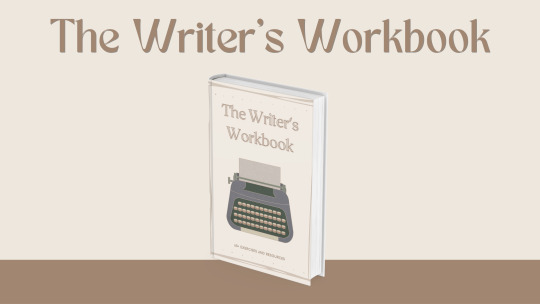
this workbook has over 60 exercises to help you develop characters, scenarios, etc. if you're ever stuck, I'm pretty sure this workbook will be your best friend.
2) author's corner (notion template)
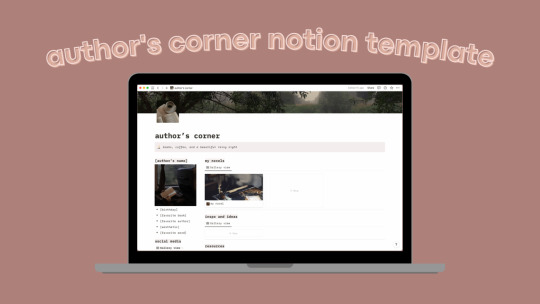
this is the most downloaded freebie in my shop! it is a notion dashboard with everything you need to organize your writing and has some templates included (like scrivener)!!
3) another notion template
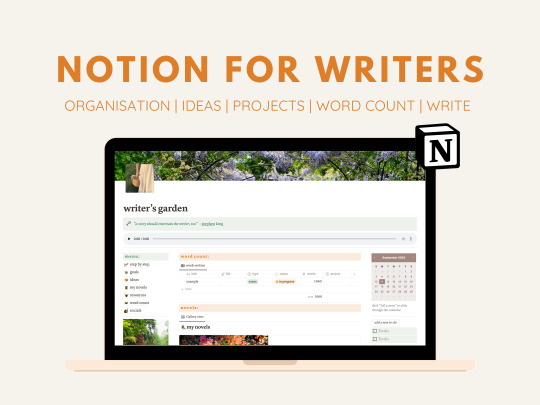
this one has two themes you can choose from: cottage-core and dark academia. they're very similar to the previous template, but this one is more recent and I added some new features. feel free to explore both and pick the one you like the most.
4) the author's journal
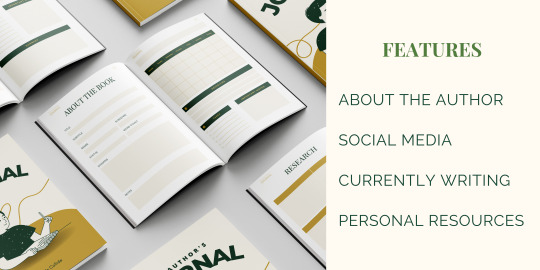
this is a cute printable with 20 pages that will help you stay on track and manage your social media accounts as a writer who shares their work online. you can also register what you're currently writing and your personal research and resources.
5) plan your book printable
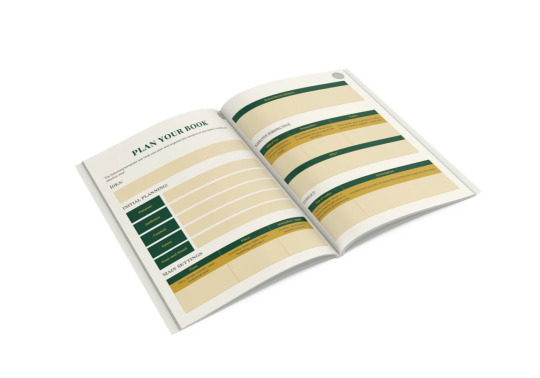
this is a 6-page printable for you to fill out and plan your book easily and effectively.
6) excel sheet to organize tasks & word-count

this is a simple excel sheet, but it is very effective for keeping track of your tasks & word-count of your novels. also, it is 100% customizable to your liking!
that's all for now! feel free to explore my gumroad shop where I have plenty of freebies to grab! also, don't forget to subscribe so that you never miss any opportunity to get a goodie for free :)
hope this post was useful!
have a nice day,
rach
#writing resources#writing#writeblr#writer tips#writing advice#writing help#writing tips#poetsandwriters#resources#research#wattpad#nanowrimo#creative writing#writerscommunity#writers#writing inspiration#writing prompts#writing reference#writerslife#writersofinstagram#software#inspiration#writing inspo#for writing#for writers#for whoever needs it#writing research#researching#we love an useful post#useful
4K notes
·
View notes
Text
Creating Fear in Your Characters: A Writers Guide
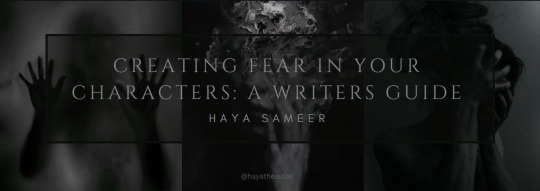
Creating authentic emotions is vital for immersive storytelling, which is why I decided to make this series on how to write different emotions. After exploring rage, and sadness it's now time to delve into fear!
Fear is a powerful emotion that can manifest in various ways, from subtle apprehension to paralyzing terror. Here's a guide on how to write fear effectively, covering different aspects of your characters' behavior and reactions.
Facial Expressions
Fear often manifests first in facial expressions, conveying the initial shock or unease. Describe these expressions to immerse readers in your character's emotional state:
Widened Eyes and Dilated Pupils: Show the eyes widening in response to a sudden threat, with dilated pupils indicating heightened alertness.
Tense Jaw and Clenched Teeth: Mention the clenching of jaw muscles or teeth, signaling internalized stress or anxiety.
Furrowed Brow and Raised Eyebrows: Describe the furrowing of the forehead and raised eyebrows, revealing worry or confusion.
Quivering Lips or Lip Biting: Note subtle lip movements like quivering or biting, reflecting nervousness or fear.
Frozen or Stiff Facial Muscles: Highlight moments of fear-induced immobility, where facial muscles become tense and rigid.
Body Language and Gestures
Fear can also be expressed through body language and gestures, showcasing your character's instinctual responses to danger or threat:
Backing Away or Recoiling: Describe your character instinctively moving backward or recoiling from the source of fear, signaling a desire to retreat.
Raised Shoulders and Tensed Posture: Show how fear causes the shoulders to rise and the body to tense up, indicating readiness for fight or flight.
Trembling Hands or Shaking Limbs: Mention the trembling of hands or shaking of limbs, reflecting nervousness or anxiety.
Covering Vulnerable Areas: Describe your character instinctively covering vulnerable areas like their neck or torso, symbolizing a protective gesture.
Fidgeting or Restlessness: Note any fidgeting or restlessness, such as tapping feet or wringing hands, as signs of inner turmoil and fear.
Vocal Cues and Dialogue
Fear can alter vocal cues and dialogue, affecting how your character speaks and communicates their emotions:
Quavering Voice or Shaky Speech: Describe the voice quivering or becoming shaky, indicating nervousness or fear.
Rapid Breathing and Gasping: Mention rapid breathing or gasping for air, showcasing the physical impact of fear on the respiratory system.
Stammering or Hesitant Speech: Note any stammering or hesitant speech patterns, reflecting the character's struggle to articulate their thoughts coherently.
Sudden Silence or Lack of Verbal Response: Show moments of sudden silence or the inability to respond verbally, highlighting the overwhelming nature of fear.
Repetitive Phrases or Vocalizations: Describe repetitive phrases or vocalizations, such as muttering prayers or chanting reassurances, as coping mechanisms in fearful situations.
Reactions and Physical Responses
Fear triggers various physical responses in your characters, showcasing the body's instinctual reactions to perceived threats:
Increased Heart Rate and Sweating: Mention the character's heart rate increasing and sweating profusely, reflecting heightened physiological arousal.
Dilated Pupils and Heightened Senses: Describe dilated pupils and heightened sensory perception, as the character's senses become more attuned to potential dangers.
Muscle Tension and Rigidity: Note muscle tension and rigidity, as the body prepares for action or defense in response to fear.
Nausea or Stomach Churning: Show how fear can lead to feelings of nausea or stomach churning, as the body's stress response impacts digestive functions.
Fight, Flight, or Freeze Response: Highlight the character's instinctual response to fear, whether it's a readiness to fight, a desire to flee, or a state of frozen immobility.
Types of Fear and Emotional Depth
Different types of fear can evoke varying emotional responses in your characters, adding depth to their portrayal and the narrative:
Startle Fear: Describe the sudden, reflexive fear triggered by unexpected events or loud noises, leading to a quick, intense reaction.
Apprehensive Fear: Show the lingering sense of unease or dread that accompanies anticipated threats or impending danger, heightening tension over time.
Terror: Depict the overwhelming, paralyzing fear that arises from extreme danger or horrifying experiences, impacting the character's ability to think or act rationally.
Phobias: Explore specific phobias that trigger irrational and intense fear responses, shaping how your character navigates their environment and interactions.
Trauma-Induced Fear: Address fear resulting from past traumas or experiences, influencing the character's behavior and emotional resilience in present situations.
Verbs and Adjectives for Writing Fear
Here's a list of verbs and adjectives to help you convey fear effectively in your writing:
Verbs: tremble, cower, gasp, quiver, shrink, freeze, recoil, sweat, pant, gulp, shudder
Adjectives: terrified, anxious, alarmed, horrified, shaken, jittery, panicked, petrified
#quillology with haya#hayatheauthor#haya's book blog#haya blogs#writers on tumblr#writer community#writing fear#writer tools#scary stories#writer blog#writer stuff#writer wednesday#writer tips#creative writing#writing emotion#writers of tumblr#writerscommunity#writeblr#writing community#writer spotlight#writer things#writing prompt#writing tools#writing stuff#writing#writing life#writing inspo#writing help#writing advice
2K notes
·
View notes
Text
❝THINGS SAID BETWEEN KISSES.❞ PART I
part II
tag me when used! <3

— "Do that again, please."
— "I missed the way you taste."
— "Don't start something you can't finish."
— "For someone who hates me, you're not pulling away."
— "There's no one like you, darling."
— "Is that a new lip balm?"
— "Don't act so shy now."
— "Tell me you love me too."
— "You look so pretty like this."
— "Can we keep doing this?"
— "Aren't you afraid of getting seen with me?"
— "Please, don't leave this time."
— "Are you sure about this?"
— "I'm sorry I can't love you the way you deserve."
— "Take me away, please."
— "I needed this, needed you."
— "I can't let you go."
— "Ask me to stop and I will."
— "My heart is all yours, love."
— "Your lips are all stained."
#writing#writers block#writeblr#writing prompt#prompt#writing ideas#writing inspiration#writing idea#writing inspo#writing help#romance#angst#fluff#romance writing#fluff writing#angst writing#romance prompt#romance dialogue#angst prompt#angst dialogue#fluff prompt#fluff dialogue#dialogue#dialogue prompt#writing dialogue#writing prompts#prompt list#kiss prompts#kissing prompts#—prompt list
4K notes
·
View notes
Text
How to use weather as a mood enhancer in scenes
Weather is more than a backdrop—it’s a tool that can subtly amplify the mood, tension, or theme of your scenes. Done well, it can evoke emotions and foreshadow events without being heavy-handed.
Melancholy:
The rain tapped against the window, steady and unrelenting, much like the weight pressing down on her chest. She pulled the blanket tighter around her shoulders, wishing the storm outside could drown out the one inside.
Restlessness:
The wind howled through the cracks of the old cabin, rattling the loose shutters. It wasn’t the kind of wind that swept things away—it was the kind that stayed and gnawed, a restless echo of her own unease.
A Happy Scene with Gloomy Weather:
Rain poured down in sheets, soaking her to the bone, but she didn’t care. She laughed, spinning in the middle of the street, her soaked dress clinging to her legs. For once, the world’s misery couldn’t touch her.
A Tragic Scene on a Bright Day:
The sun was too bright, its warmth mocking the cold numbness spreading through him. People bustled past, smiling under the clear blue sky, while he sat on the curb, clutching the letter that had just ended everything.
In a Chase Scene:
Fog blanketed the forest, turning the trees into looming specters. Each snap of a branch or crunch of leaves felt amplified, like the forest itself was working against him. He couldn’t see his pursuers, but he could feel them closing in.
During a Confrontation:
The wind picked up as they stood in the open field, her hair whipping around her face like a fury she couldn’t contain. Lightning cracked in the distance, illuminating the raw anger in his eyes. Neither of them would back down.
Redemption Arc:
The first snow of the season fell gently, covering the world in white. It felt like a fresh start, even if he didn’t deserve one. He reached out a hand, watching the flakes melt against his skin, and wondered if he could ever be that clean again.
Grief:
The fog rolled in every morning like clockwork, smothering the town in its heavy embrace. It had been that way since the accident, as if even the weather couldn’t bear to let go of what had been lost.
Loneliness:
The snow piled up around the cabin, burying the path and muffling every sound. She’d never felt the silence so keenly before, as if the world had decided to forget her existence entirely.
Isolation:
The heat hung heavy in the air, making it hard to breathe. The cracked earth stretched out in every direction, offering no shade, no solace. She was utterly alone.
Subtle Anxiety:
A bead of sweat slid down her back, but she wasn’t sure if it was from the heat or the unease that had settled under her skin. The humidity pressed in, making the air feel heavier, like it carried secrets she didn’t want to uncover.
Lingering Sadness:
The drizzle wasn’t enough to drench anyone, but it clung to her skin, a persistent chill she couldn’t shake no matter how fast she walked.
Weather isn’t just a backdrop—it’s a storyteller in its own right. Whether it mirrors your character’s emotions, foreshadows danger, or contrasts with the scene’s tone, it can elevate your writing when used thoughtfully. Just remember: subtlety is key. Let weather enhance your story, not overshadow it.
#writerblr#writers#creative writing#creative writing tips#Writing tips#fanfiction#fanfic writing#Fanfic writer#fanfiction writing#fiction writing#writing#am writing#tumblr writing community#writers on tumblr#writing advice#fic writing#writing community#writing inspo#writers on ao3#writers on ao3 writers on tumblr#AO3 fic#ao3 writing community#writing stuff#wip#writers block#writer things#writer life#writer struggles#writing help#xyywrites
380 notes
·
View notes
Text

commonplace
#art#help my sanity#books and libraries#journal#commonplace#commonplace book#planner#bujo#bullet journal#writing#commonplace journal#commonplacing#reading journal#journal inspo
294 notes
·
View notes
Text
MASTER LIST OF INSTRUMENTAL PLAYLISTS FOR WRITING (OR FOR STUDYING, MAKING ART, ETC.)
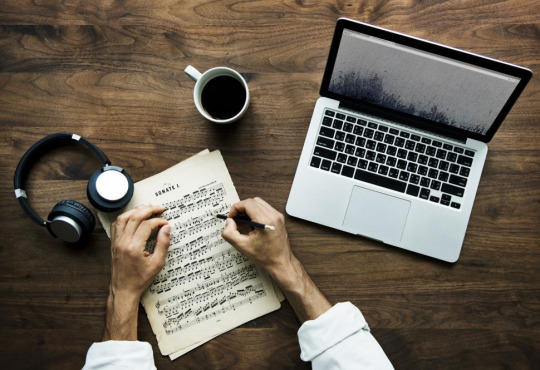
I find that the perfect writing playlist can GREATLY enhance the writing experience. Even if it doesn't make your writing "better" (which it can, since it helps writers with visualization, tone, and mood), it can definitely make your writing flow easier!
Personally, words distract me when I'm writing, either by breaking my train of thought or by getting me too into the music so that I'm jamming out to my favorite tunes instead of writing.
Therefore, I've amassed a vast knowledge of instrumental music across a variety of media over a course of many years. Now here I am, deciding to share all of them with you!
Maddy’s Favorite Instrumental Songs
Just like the title says. All of the best pieces of instrumental music I've ever heard, compiled together with no regard for genre. It can be a bit of a whiplash playlist, but some amazing recs in there that I just like listening to in my free time, not just for writing.
Maddy’s Ultimate Instrumental Playlist
A mega compilation of 550+ fantastic instrumental music from a variety of media and genres. Kind of a whiplash playlist if you put it on shuffle, but is a great start for anyone looking to find what kind of instrumental music they like! Playlist Groupings in Order: Independent instrumental songs, live action movies, animated movies, animated tv shows, live action tv shows, video games.
Maddy's Instrumental for Sleep
Some more chill vibe instrumental for people who either A) want to sleep or B) want a relaxed playlist that won't distract you with loud volume and sudden changes in tempo or melody.
MISC PLAYLISTS:
you're a haggard adventurer discovering worlds beyond your wildest dreams
Music to inspire wonder and wanderlust, the kind of feeling you get when you finally reach the end of a mountain hike and see the world stretching out before you.
you're a hero who's just lost everything
Basically the most sad instrumental music I could find. A playlist for grief and revenge.
more beneath the cut :)
you're a cowboy in the great American West
Cowboy instrumental for all of your ambient and writing needs. Or if you just really want to feel like a cowboy.
you're a divine witness
Epic choir music (no English). Most religious, some not, but all kind of have that eerie sacred vibe. I listen to this while writing my book about angels and demons.
you’re a scholar uncovering the secrets of the universe
Great chill study playlist! Has the kind of same exploratory/discovery type feel as the haggard adventurer playlist, but more dark academia.
you’re a villain plotting to take over the world
Villain-coded instrumental! Sinister, dark, and/or unsettling.
you're an academic weapon
HIGH BPM STUDY PLAYLIST! Keeps me focused, hyped, and helps me work faster!
you're an ancient god
Playlist that gives an ancient/eerie vibe. But some ancient gods are merciful- so there are some upbeat songs for wonder and awe!
you're falling in love
Music that encapsulates what I think falling in love feels like. Very beautiful, tender, and uplifting instrumental.
you're fighting the final battle
Intense and epic battle music for all of your fight-scene-writing needs! Good for getting shit done, but isn't necessarily restricted to high BPM like the academic weapon playlist.
you're having a tea party
Refined instrumental for a tea party, including classical, big band, and some miscellaneous goodies.
you're in a chase scene
Music for writing chase scenes. Pretty good hype music, too. Includes soundtracks from classic chase scenes in popular media!
you're in the medieval times
Medieval-sounding music for all of your ambient and/or writing needs.
you’re in your childhood room. the door is open a crack. people talk softly downstairs.
A playlist dedicated to nostalgia, to the feeling of lying in bed with your nightlight on after being too tired to stay awake at your family get-together. Could either make your day or break your heart lmao
you're the happiest you've ever been
Lighthearted instrumental meant to lift your spirits! A playlist dedicated to the joys of the little things.
#writing#writers#writeblr#booklr#creative writing#studying#writing playlist#roleplay#writing tips#writing advice#writing help#writing inspo#writing inspiration#inspo#music#music rec#instrumental music
2K notes
·
View notes
Text


another chaotic monday🌕
back in my role as a teachers assistant. exam season has started and I’ve been trying to catch up on my to-dos but it seems like every time I’m done with one thing another task gets added. by now I’ve started to skip everything that I don’t have to hand in because I simply don’t have the time to do all tasks, which bothers me a lot though. on top of that the depression brain fog is back which is making things a lot harder. things will get better again.
currently working on: essay about the relevance of the UN
#high school#high school students#high school studyblr#high school senior#studyblr#studying#studyspo#study aesthetic#do your homework#i have homework to do#studying inspo#studying inspiration#study blog#study motivation#study inspiration#study notes#exam preparation#exam season#exams#dark academia#dark aesthetic#chaotic academia#homeworkhelp#homework help#i should be doing homework#essay writing#essay#exam stress#exam study#autumn aesthetic
218 notes
·
View notes
Text
Writing Villain Organizations
masterlist. main navigation.
bluebxlle_writer on instagram
1. Goal & motivation
To pose a threat to your main characters, your villains need a clear goal — preferably one that directly negates your MC’s goal. But that’s not enough — they also need a clear motivation to justify their goal.
Now, which one should you flesh out first? Goal or motivation?
The answer is : it’s up to you. You can start by giving your villain organization a clear goal before brainstorming possible motivations that would support this goal; or you can come up with a backstory which narrates their motivation then set up a goal that aligns with said motivation.
2. Influence
To be memorable, your villain organization must have some sort of influence on your main characters and the general public.
An underground criminal organization that brings annoyance to your main characters because they wreak havoc everywhere they go and are impossible to catch as they have their ways to evade law.
A supernatural cult that brings fear to the public because they have the most powerful people on their side who won’t hesitate to kill anyone who stands in their way.
A cryptic society that brings a sense of uneasiness to the MCs because they’re unpredictable and have actions that don’t seem to make sense, yet always results in casualties.
3. Leader
Behind every villain organization is a leader who can control all the worst and most evil people in your story. This should be something frightening, so make sure to clearly establish how they obtained their power as a leader.
Expertise — they have expertise on a certain skill that’s deemed important, such as mastery of a deadly spell.
Charm — they can sway and manipulate people as they please.
Cruelty— they’re evil and ruthless, striking fear within the group and coaxing everyone to listen to them.
Ambitions — they have a strong goal and plan, convincing the entire organization that he’s the best man to achieve that goal.
Savior — they “saved” several villains from a gruesome end and played the role of “savior”, earning gratitude and awe.
4. Disputes
Selfish and goal-driven villains are bound to trigger disputes within the organization. Here are a few conflicts that could trigger disputes :
Factions — the organization is split into two factions ; one that supports the current leader, and one that support someone who promises to bring a “real” change if he were to become leader.
Betrayal — when one villain betrays the organization and the leader finds out, this may trigger an all-out dispute ; some members defending the betrayer and the rest wanting to kill them.
Absense of a leader — When the leader dies or is incapable of issuing orders, members of the villain organization may fight for the leader’s seat as they want to use the position to reach their personal goals.
5. Parallel
If your main characters are also part of an organization, a villain group can serve as a parallel to your MC’s organization.
While the villains operate under personal goals and are only bounded by fear to their leader, your MCs have a common goal and are willing to work together to reach it.
While the villains don’t care about public safety and only ensure the smooth operation of their missions, your MCs always put civilians first.
While the villain strictly prohibit emotional relationships; let alone romantic relationships, your MCs are free to be with whoever they want.
#writers on tumblr#writing things#writers#writerslife#writersociety#writing tips#writing advice#writing villains#female villains#villains#writers supporting writers#writers tips#writers help writers#writing tip#writing inspo#writing inspiration#writing techniques#writers of tumblr#writers helping writers#writing
374 notes
·
View notes
Text
Ideas to Show Secret Pining - II
*aligning their schedule with their crush's*
"You need to teach me football." // "But you're already the QB." // "I need help with it's theory."
"I was told I should be nice to you because you like nice people."
*sneaking glances at their crush every chance they get.*
*getting protective of their crush*
*running background checks on their crush's potential love interests.*
*pretends to be bad at something just so they can get coached by their love interest*
"I will keep that in mind."
"You like it, right? So why not?"
"This can happen but only between us."
"I didn't know I'd see you here!" (definitely went there just to see them)
*suddenly develops the power to flirt*
*actual simping*
*writing about them in their journal*
*dedicating something valuable to their love interest*
*learning about their love interest so that they can engage in conversations with them*
*blabbers like a fool because they like them so much* (this character is smooth with everyone but their crush)
- ashlee
#writers on tumblr#writerscommunity#writing#books#writer#write#writingtips#creative writing#fanfic writing#tips and tricks#writing inspo#writing inspiration#writings#writing love#writing tools#writing help#writing tips#writing reference#writing resources#characters#fanfiction#fanfics#fics#writing fanfic#writing advice#writers#fiction writing#fiction#romance#writing romance
180 notes
·
View notes
Text
25 "I'm in love with you and I'm scared to lose you" prompts!
(feel free to use!!! plsplspls tag me I'd love to readd. especially 3, 9, 11, 14, 19 and 24 ahhh<33 | @urfriendlywriter )
"can i.. hold your hand?"
"i trust you, [name]." ✿
"i come offering hugs :) a lott of hugs"
"i feel stupid, why do u make me grin like a spineless fool whenever i am around you?" >\\\<
them staring at you from across the room and getting flustered when u stare at them back <AAAAAH3
"I'll live for you, love."
"I'll love you right in all universe"
"... you trusted in me when everything else was pointed against me.."
them tenderly tucking a hair behind ur ear (my c. ai be like >\\\<)
listening to their heartbeat while laying on their chest. :')
a soothing, and tender "come here, sweetheart"
"you're not alone.. I.." they cup their lover's face in their hands, "I'm here for you, and I'll always be."
"what else do i need, when i have my world in my arms?"
leaning forehead against each other's [AAAHHH is my toaster waterproof-]
"what will i do without you? thank you-"
^ "no, thank YOU, [nickname]. thank you for coming into my life." *cries in me when??*
"you.. you're a dream." (rip my heart)
^ "no, my love. you are the dream and I the lucky one to be living this dream with you" imagine them saying this while their lips hover the other's, before giving in.
them taking your hand and placing it on their chest, "feel this heartbeat? this is how much effect you have over me."
"i don't have to search for truth when you say you love me, i can already see it all in ur eyes." [bawling into my pillows]
a sigh of release when they're finally in your arms like they longed for it all day !!!!!
laying with your back to their chest!!! their hands around your waist (the way I'd MELTT so fast)
"I am in love with you." ".... we've been together for the past several years." "that's what. What are you doing to me, darling?"
"i never stopped falling in love with you."
lazy kisses, softly sighing and gasping into each other's mouths.!! [me when yall. its ab time ffs.]
#romantic dialouge prompts#writer prompts#otp prompts#dialogue prompts#romance writing#imagine your otp#urfriendlywriter#writeblr#writing prompts#writing inspiration#romance prompts writing#romantic gestures#romantic tropes#soft gestures#soft love#soft prompts for lovers#soft prompts#soft dialogue prompts#fluffy prompts#fluff prompts#friends to lovers#domestic lovers prompts#lovers prompts#writing inspo#writing help#intimacy prompts#physical gestures#adorable gestures#writing romance#romance prompts
2K notes
·
View notes
Text
How to Get Started with Worldbuilding for Fantasy Writers
Hey fellow writers!
Worldbuilding can feel like a Herculean task, but it’s one of the most rewarding parts of creating a fantasy novel. If you're getting stuck, Here are some tips that have helped me, and I hope they’ll help you too!
Start with the Basics
Geography
- Map out the physical layout of your world. Think about continents, countries, cities, and natural features like mountains, rivers, and forests.
Climate and Ecosystems
- What are the climate zones and ecosystems like? How do they shape the lives of your inhabitants?
Create a History
Origins
- Dive into how your world came into existence. Are there creation myths or ancient civilizations that set the stage?
Major Events
- Outline key historical events. Wars, alliances, discoveries, and disasters can add so much depth.
Develop Cultures and Societies
Cultures
- Craft diverse cultures with unique customs, traditions, and values. What do they wear? What do they eat? How do they express themselves through art?
Social Structure
- Define the social hierarchy. Who holds power? What are the roles of different classes or groups?
Establish Magic and Technology
Magic System
- Set the rules and limitations of magic. Who can use it? How does it work? What are its costs and consequences?
Technology
- Decide on the level of technological advancement. Is your world medieval with swords and castles, or does it have steampunk elements?
Design Political and Economic Systems
Governments
- Create various forms of government. Are there kingdoms, republics, or empires? How do they interact?
Economy
- Define the economic systems. What are the main industries and trade routes? How do people earn a living?
Build Religions and Beliefs
Religions
- Develop religions and belief systems. Who are the gods or deities? What are the rituals and holy sites?
Myths and Legends
- Craft myths and legends that influence the culture and behavior of your characters.
Craft Unique Flora and Fauna
Creatures
- Invent unique creatures that inhabit your world. Consider their habitats, behaviors, and interactions with humans.
Plants
- Design plants with special properties. Are there magical herbs or dangerous plants?
Incorporate Conflict and Tension
Internal Conflicts
- Think about internal conflicts within societies, such as class struggles, political intrigue, or religious disputes.
External Conflicts
- Consider external threats like invading armies, natural disasters, or magical catastrophes.
Use Maps and Visual Aids
Maps
- Create maps to visualize your world. This helps you keep track of locations and distances.
Visual References
- Use images or sketches to inspire and flesh out your world.
Stay Consistent
Consistency
- Keep track of the details to maintain consistency. Use a worldbuilding bible or document to record important information.
Feedback
- Share your world with others and get feedback. Sometimes fresh eyes can spot inconsistencies or offer new ideas.
Let Your Characters Explore
Character Perspective
- Develop your world through the eyes of your characters. How do they interact with their environment? What do they know or believe about their world?
Be Flexible
Adapt and Evolve
- Be open to changing aspects of your world as your story develops. Sometimes the best ideas come during the writing process.
#writer#writing#writer things#writerblr#writerscorner#writing inspiration#writing tips#writers and poets#ao3 writer#author#worldbuilding#sci fi and fantasy#fantasy writer#fantasy#dungeons and dragons#writing inspo#writing resources#writing help#writers community#writing prompt#writer stuff#writing blog#writers on tumblr#writers block#writer problems#writerscommunity
732 notes
·
View notes
Text
The right FREE tools to write a book
hello hello, it's me!
today I was thinking of how much you loved my masterlist featuring some free tools for writers, and I thought I would do something like that again but, this time, featuring just one or two tools per step while getting the best of "the writer's workbook" (which is also free).
before going any further, for those who don't know, "the writer's workbook" is, as the name says, a workbook for writers, with over 90 pages. it has lots of sheets divided into categories, to help you build the skeleton of your novel. (know more about it here).
however, we can get the most out of it using other complementary tools to ease this process.
Brainstorming
Reedsy generator - it's one of my favorites, and it can be quite useful when you're stuck and want to get an idea. you're free to make changes to it so that it is as unique as possible.
Mindmap
Lucidspark - although it has a premium version, I find it so helpful when it comes to making a mindmap. I've used it multiple times before, including for college assignments, and it's one of the best I've found so far.
Mindmup - I'm sharing this one here as an alternative to lucidspark, since this one doesn't require to create an account, and you have access to unlimited maps. however, in my opinion, it is not as good or intuitive as lucidspark is.
Come up with names
Behind the name - it's a classic, but one of my favorites. you can search every name you could ever imagine, and get its meaning, history, variations, etc. it still has some tools you can use such as a name generator, anagrams, and much more.
Make a profile
Fake person generator - although it was not created for authors, you might find it useful since it gives lots of details and you can be interested in some fields.
Character generator - this one was made for writers, and is simple and easy to use.
Family tree
Family echo - it's so simple yet so helpful.
Maps
Inkarnate - it has a paid version, but you can use it for free and create a great map.
Politics
Filteries - this is sooo complete and accurate!
hope this was helpful! have a nice day <3
#writing resources#writing#writeblr#writer tips#writing advice#writing help#writing tips#poetsandwriters#resources#research#wattpad#nanowrimo#creative writing#writerscommunity#writers#writing inspiration#writing prompts#writing reference#writerslife#writersofinstagram#software#inspiration#writing inspo#for writing#for writers#for whoever needs it#writing research#researching#we love an useful post#useful
5K notes
·
View notes
Text
The Writer's Guide to Authentic Wounds and Fatalities
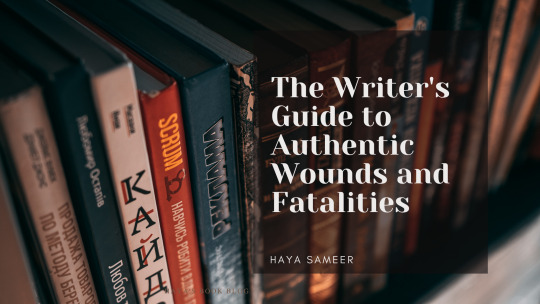
Writing fatal injuries in a story requires a delicate balance between realism and narrative impact. The portrayal of these life-altering events can evoke strong emotions in readers and shape the trajectory of your characters' journeys. In this blog, I will explore the intricacies of depicting fatal injuries in a manner that feels authentic, engaging, and respectful to the gravity of such circumstances. By understanding the nuances of fatal injuries, you will be equipped to craft compelling narratives that resonate with your readers.
Writing Fatal Injuries
When it comes to writing fatal injuries, it is crucial to approach the subject with care and accuracy. Fatal injuries carry immense consequences for your characters and can shape the trajectory of your story. By delving into the intricacies of portraying fatal injuries authentically, you can ensure that the gravity and impact of such events are effectively conveyed to your readers.
Choosing the right injuries for your story
Selecting the appropriate fatal injuries for your narrative involves considering various factors. Ask yourself: What purpose does this injury serve within the story? How does it affect the characters and the overall plot? Conduct thorough research to identify injuries that align with your story's context and resonate with the emotional journey of your characters.
For example, in a historical drama, you may research common fatal injuries during a particular era, such as battlefield injuries, diseases, or accidents prevalent at the time. In a crime thriller, you might explore the portrayal of fatal gunshot wounds or traumatic injuries resulting from violent encounters. By aligning the injuries with the context and themes of your story, you create a more immersive and believable experience for your readers.
Researching the mechanics of fatal injuries
To portray fatal injuries convincingly, it is essential to delve into the mechanics behind them. Understand the specific anatomical structures and systems involved, as well as the forces or mechanisms that can lead to fatal outcomes. Explore medical resources, consult experts if possible, and gather insights into the physiological and psychological implications of such injuries.
For instance, if your character suffers a fatal stab wound, research the anatomy involved, the potential organs affected, and the potential consequences such as internal bleeding or organ failure. By understanding the specific details and implications of the injury, you can describe the physical and emotional toll it takes on the character with greater accuracy and depth.
Depicting the immediate aftermath
When writing about fatal injuries, vividly describe the immediate aftermath to capture the intense emotions and physical realities. Consider the sensory details, the shock and disbelief experienced by characters, and the chaotic environment that often surrounds such events. Balancing realism with the needs of your story, create a scene that immerses readers and evokes empathy.
For example, if a character experiences a fatal car accident, you can depict the chaos at the scene, the character's disorientation, and the reactions of witnesses. Emphasize the sensory details such as the sound of screeching tires or the smell of burning rubber, creating a visceral experience for your readers.
Emotional and dramatic impact on the narrative
The impact of fatal injuries extends beyond the immediate moment. Explore the ripple effects on other characters, relationships, and the overall plot. Delve into the emotional responses, grief, guilt, anger, or determination that arises in the aftermath of loss. Utilize these emotional arcs to deepen character development and drive the narrative forward.
For instance, the loss of a loved one due to a fatal illness might lead to grief and strained relationships among the remaining family members. The emotional journey of a character grappling with guilt and seeking redemption after causing a fatal accident can become a central theme in your story. By delving into these emotional arcs and their consequences, you add depth and resonance to your narrative.
Writing Minor Injuries
While fatal injuries may capture our attention with their dramatic impact, it is equally important to pay attention to the portrayal of minor injuries in your writing. Minor injuries, though less severe, can still significantly affect your characters and contribute to the authenticity of your story. In this section, we will explore the art of depicting minor injuries, ensuring that they are not overlooked or trivialized. By delving into the nuances of minor injuries, you can add depth and realism to your characters' experiences.
Types of minor injuries to consider
When crafting your story, it is essential to consider a range of minor injuries that can occur. These injuries can include cuts, bruises, sprains, minor burns, or even minor fractures. Each type of injury carries its own unique characteristics, associated pain levels, and recovery processes. By understanding these distinctions, you can create accurate and believable depictions that resonate with your readers.
For example, a character who sustains a cut on their hand may experience sharp pain, the sight of blood, and the need for immediate first aid. On the other hand, a character with a sprained ankle may struggle with mobility, experience swelling, and require rest and care for a few days. By paying attention to these specific details, you can enhance the realism of your storytelling.
Conveying pain and discomfort
When writing about minor injuries, it is important to effectively convey the pain and discomfort experienced by your characters. Consider describing the sensation of pain, the throbbing or stinging feeling, and how it affects their daily activities or interactions. Showcasing the emotional impact of pain, such as frustration, irritation, or vulnerability, can deepen the readers' connection to the character's experience.
For instance, if a character suffers from a sprained wrist, you can describe the dull ache that persists, making simple tasks like typing or holding objects challenging. By capturing these small but significant moments, you immerse readers in the character's struggle and create a more realistic portrayal.
Balancing realism with narrative pace
While it is important to depict minor injuries realistically, it is also crucial to strike a balance with the overall pace and momentum of your story. Consider the significance of the injury within the larger context of your narrative. Some injuries may require more detailed attention and impact the plot, while others may serve as background elements. Adjust the level of detail and focus accordingly, ensuring that the portrayal of minor injuries aligns with the narrative's flow.
For example, a small cut on a character's finger may not require an extensive description unless it becomes infected or triggers an unexpected consequence. By aligning the portrayal of minor injuries with their narrative relevance, you maintain a consistent pace while still acknowledging their impact on your characters' lives.
Writing Bloodshed And Realistic Blood Loss
When writing about wounds and injuries, it is essential to consider the amount of blood loss your characters may experience. Realistic portrayal of bloodshed can enhance the authenticity of your scenes and immerse readers in the gravity of the situation. In this section, we will explore the factors influencing blood loss and techniques for accurately depicting it in your writing.
Understanding blood loss and its impact on the body
To authentically portray blood loss, it's crucial to have a basic understanding of how the human body responds to injury. Research the circulatory system and the role of blood in transporting oxygen and nutrients throughout the body. Consider the different types of blood vessels and their potential for bleeding when injured. This knowledge will help you create realistic scenarios and determine the appropriate level of blood loss for specific injuries.
Factors influencing blood loss in different injury scenarios
The amount of blood loss can vary depending on the severity and location of the injury. Factors such as the size of blood vessels, the rate of bleeding, and the body's ability to clot play a significant role. For example, a deep laceration in an artery will result in more substantial blood loss compared to a superficial cut on the skin. Consider these factors when describing injuries and their resulting bloodshed.
Techniques for accurately portraying blood loss in writing
There are several techniques you can use to convey the realistic impact of blood loss in your writing. Describing the color, consistency, and flow of blood can provide vivid imagery. You can also include physical symptoms such as dizziness, weakness, or fainting that may accompany significant blood loss. Additionally, consider the emotional response of your characters and how they react to the sight of blood or their own injuries.
By incorporating these techniques, you can create scenes that evoke a visceral response in readers and enhance the authenticity of your writing.
Bruises: Colors, Progression, and Pain
Bruises are a common result of injuries, and understanding how they form, change in color, and cause discomfort can greatly enhance the realism of your writing. By accurately describing bruises, you can bring depth to your characters' injuries and portray their healing process convincingly.
Understanding the stages and colors of bruises
Bruises go through distinct stages of color as they heal. Initially, they may appear red or purple due to the broken blood vessels beneath the skin. Over time, the color changes to blue, green, yellow, and eventually fades to a brown or yellowish hue. Understanding this color progression can help you accurately describe the age of a bruise and the healing process.
For example, a fresh bruise might be vivid purple, indicating recent trauma, while a fading bruise may have a yellowish tinge, suggesting that healing has begun. By incorporating these color details, you can add realism to your characters' injuries and track the passage of time within your narrative.
Depicting the progression of bruises over time
As bruises heal, they often change in appearance and size. Initially, a bruise may be small and localized, but it can gradually spread and become more extensive. Describing this progression can provide a sense of the healing process and the passage of time within your story.
For instance, a character who sustains a significant blow to the face may develop a bruise that starts as a small spot near the eye but expands to cover a larger area over the next few days. By accurately portraying the progression of bruises, you enhance the authenticity of your characters' injuries and their recovery.
Conveying the pain and sensitivity associated with bruises
Bruises can be painful, sensitive to touch, and affect a character's movement and daily activities. Describing the pain and discomfort experienced by your characters can create empathy and immerse readers in their physical ordeals.
Consider conveying the tenderness of a bruise when pressure is applied, the throbbing sensation, or the limitation of movement due to the pain.
Remember The Side Effects
Injuries, whether minor or severe, often come with a range of side effects that can significantly impact your characters' lives. These side effects can extend beyond the physical realm and encompass emotional, psychological, and social aspects.
Physical side effects
Injuries can have profound physical side effects that go beyond the immediate pain and discomfort. Consider the potential consequences such as limited mobility, impaired coordination, chronic pain, or the need for assistive devices like crutches or braces. Describing these physical side effects can add depth to your characters' struggles and provide a realistic portrayal of their healing journey.
For example, a character who sustains a leg injury may experience difficulty walking, require physical therapy, or have long-term complications that affect their day-to-day activities. By addressing these physical side effects, you create a more nuanced depiction of the aftermath of injuries.
Emotional and psychological side effects
Injuries can have a profound emotional and psychological impact on characters. They may experience fear, anxiety, trauma, or a loss of confidence. Consider how the injury affects their self-image, relationships, or mental well-being. Explore the emotional journey your characters undergo as they navigate the aftermath of their injuries.
For instance, a character who survives a near-fatal accident may develop post-traumatic stress disorder (PTSD) and struggle with recurring nightmares or panic attacks. By incorporating these emotional and psychological side effects, you can deepen the complexity of your characters and their responses to traumatic experiences.
Social implications and changes
Injuries can also lead to significant social changes for your characters. They may face challenges in their personal relationships, encounter stigma or discrimination, or experience changes in their roles or identities. Explore how the injury affects their interactions with others and their sense of belonging in the world.
For example, a character who sustains a facial injury may encounter judgment or stares from others, leading to self-consciousness or isolation. By addressing the social implications and changes resulting from injuries, you can create multi-dimensional characters and explore the impact of their injuries on their social dynamics.
By incorporating these various side effects into your writing, you bring depth and authenticity to your characters' experiences and showcase the wide-ranging impact of injuries.
Conclusion
Writing authentic wounds and fatalities requires attention to detail and a deep understanding of the physical, emotional, and psychological aspects involved. By following the guidelines and exploring the subheadings discussed in this guide, you can create compelling and realistic portrayals of injuries in your writing.
Remember to conduct thorough research on the specific injuries you want to depict, understanding their mechanics, symptoms, and potential outcomes. Consider the immediate and long-term effects on your characters, both physically and emotionally. Incorporate sensory details to immerse readers in the experience, describing the pain, bloodshed, colors of bruises, and the progression of healing.
Additionally, don't forget to address the side effects that injuries can have on your characters' lives. Explore the physical limitations, emotional struggles, and social implications that arise from their injuries. By delving into these aspects, you can create well-rounded characters and compelling narratives that resonate with readers.
I hope this blog on forging epic battles will help you in your writing journey. Be sure to comment any tips of your own to help your fellow authors prosper, and follow my blog for new blog updates every Monday and Thursday.
Looking For More Writing Tips And Tricks?
Are you an author looking for writing tips and tricks to better your manuscript? Or do you want to learn about how to get a literary agent, get published and properly market your book? Consider checking out the rest of Haya’s book blog where I post writing and publishing tips for authors every Monday and Thursday! And don’t forget to head over to my TikTok and Instagram profiles @hayatheauthor to learn more about my WIP and writing journey!
#hayatheauthor#haya's book blog#haya blogs#writers on tumblr#writer community#writer tools#writer blog#writer stuff#writer wednesday#writer tips#creative writing#writers of tumblr#writerscommunity#writeblr#writing community#writer spotlight#writer things#writing prompt#writing tools#writing stuff#writing#writing life#writing inspo#writing help#writing advice#writing inspiration#writing ideas#writing things#writing tip
4K notes
·
View notes